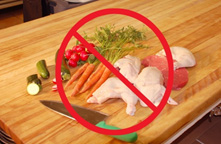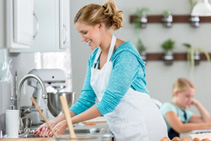What is salmonellosis?
Salmonellosis is an infection caused by bacteria, called Salmonella. These germs live mostly in the intestines of animals and birds.
What are symptoms of salmonellosis?
- Sudden diarrhea (loose poop) that can be bloody
- Sudden headache
- Stomach pain
- Fever
- Nausea
- Vomiting
- Dehydration, especially in young children, elderly, and those with a weakened immune system
It usually takes between 6 hours and 3 days after contact with the germ before you feel sick. Symptoms may last for 4 to 7 days, and can vary from mild to severe. Some people may not even show symptoms at all.
How does salmonellosis spread?
Salmonellosis is mostly spread from animal to person through the “fecal-oral route”:
- drinking and eating contaminated water and food (e.g., poultry and poultry products, such as raw/undercooked chicken), raw milk and milk products, raw, unwashed fruits and vegetables)
- touching infected pets and animals and their feces and then touching your mouth
- person to person through “fecal-oral route” is possible, especially when diarrhea is present

How long is it contagious?
A person is capable of passing the infection to others as long as the germ is present in their feces. This will last during the infection, and can continue for several months afterwards.
How is salmonellosis treated?
Most people get better without any medical treatment. If you or your child develops these symptoms, see your health care provider. Drinking plenty of fluids to stay hydrated is important to getting better. In more severe cases, your health care provider might prescribe antibiotics.
People who work with food or water and childcare or health care providers may be advised to stay home to minimize the spread of infection.
How is salmonellosis prevented?
Ways to prevent infection include:
- Wash your hands often with warm water and soap, especially before and after preparing foods, before eating, and after handling diapers and using the washroom. This is the best way to prevent infection.
- Practice safe food handling, including washing all uncooked fruits and vegetables in clean water, and storing, cooking, cooling, and reheating your food properly. Try to use separate cutting boards for raw and cooked meats. Avoid preparing food if you are sick.
- Avoid drinking untreated water, especially when travelling. Drink only pasteurized (treated) milk and milk products.

References:
- Heymann, D.L. (Ed.). (2015). Control of communicable diseases manual (20th ed.). Washington, DC: American Public Health Association.
- Ontario. Ministry of Health and Long-Term Care. (2014). Infectious diseases protocol, Appendix A: Disease-specific chapters, Chapter: Salmonellosis. Toronto, ON: Queen’s Printer for Ontario.
- Government of Canada. (2017). Salmonellosis (Salmonella). Retrieved from https://www.canada.ca/en/public-health/services/diseases/salmonellosis-salmonella.html.

